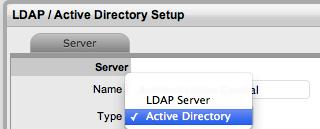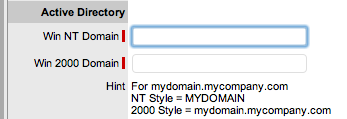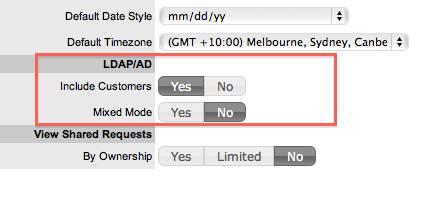Active Directory Integration
Active Directory is a unique implementation of the LDAP standard, as
the requirements for communication need to conform to the Microsoft™ Windows
Authentication protocols. To meet this need, it is necessary to enter
all domains from which Users will authenticate. Multiple sources of Active
Directory can be synchronized with the system, if required.
Configuring the Active Directory Integration
To configure the Active Directory integration:
Select
Setup>LDAP
Click
New
The LDAP/Active Directory Server screen tab is displayed.
Enter
the Server Name
Select
Active Directory within the Type drop down list

Define
all the Domains from which Users will be authenticated
Domains will need to be entered in both NT and Windows 2000 domain
naming systems formats. This is because Active Directory conforms
to Microsoft™, Windows NT and Windows 2000 authentication protocols.
Make entries with care, as they are not validated against the Directory
Server by the system Domain Editor.

Here is
an example of both the naming conventions for the domain:
mydomain.mycompany.com
NT Style = MYDOMAIN
2K Style = mydomain.mycompany.com
Click
New and enter domain information
Click
Save
Using
the drop-down arrow, select the Default Domain, which is used in the
following three ways:
Enter
all other required fields to configure the Directory Server
Settings |
Description |
Security |
Determines how the integration layer
will authenticate. For Active Directory this should be set
to Cleartext– Username + Password. Anonymous connections
to Active Directory are rarely enabled. |
Server Host |
Enter the hostname
or IP address of the Active Directory
Server. On a Windows NT domain this will be the primary domain
controller. |
Server Port |
The default Active Directory Server
Port is 389. This is rarely changed. |
Username |
Used by the system to authenticate against
the Active Directory Server when reading account information.
The domain prefix/suffix will be appended, based on the default
domain, when connecting to the Server. |
Password |
Enter the Password for the Username account. |
Users Node |
The component of the base domain name
that refers to the location of the User Groups .For
example, if the location of the User Groups is the following:
ou=UserGroups, ou=MIS, dc=myoffice,
dc=mycompany, dc=com (See
LDAP/Active
Directory Advanced Settings for information on Group configuration.)
Groups must be in the default domain,
in this case myoffice.mycompany.com.
The Users Node only needs the location of the Groups within
the default domain, so the Users Node in this example will
be: ou=UserGroups, ou=MIS. |
Locale |
Default
Timezone |
Select the default Timezone to be applied
to all User accounts imported via Active Directory. |
Click
Save.
Repeat the above process to add more than one authentication server
for authorizing User access.
Test Button

The Test button creates a connection to
the Active Directory Server, applying the configuration settings. If successful,
it will attempt to determine how many Users are in each group and display
a Results Screen.
Sync Button

The Sync button runs the synchronization process to import all Users
from the Server Directory. If new Active Directory Accounts have been
created and those Users require immediate access to the system, a manual
synchronization would be used.
Only one synchronization can run at a time. When multiple Users need
access, create the accounts, then run a single manual synchronization.
A manual synchronization may take some time as it depends on the connection
speed with the external service. The manual synchronization works best
for small directories. Larger Active Directory implementations can take
some time to propagate the changes, so account information may not be
immediately available.
Importing Customers
Customer details can be imported
using Active Directory by enabling the option, if required. When the system
is setup to synchronize with Active Directory, move to the Setup>Privileges>Customer
tab and enable the Include Customers option.

If there is a need to create
Customers using Active Directory and the system's internal authentication
capability, Mixed Mode authentication can also be enabled. After the option
to Include Customers is set to Yes in the Customer Privilege tab, the
Mixed Mode field is displayed. Set this option to Yes to allow Customers
to be created directly in the system and using Active Directory.
Imported Account Usernames
Accounts imported from Active Directory
use the UPN as the Username, as opposed to the NT style login. The domain
component of the UPN is derived from the selected domain in the popup
on the login page, which means Users need to enter their login name only
to connect to the support application.
Login details are passed directly to the
directory server for authentication and are not retained within the service
management system.


